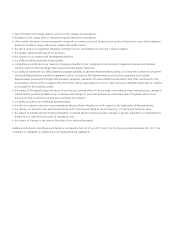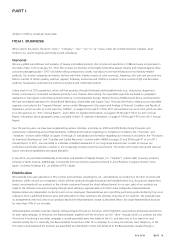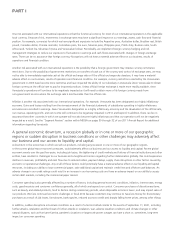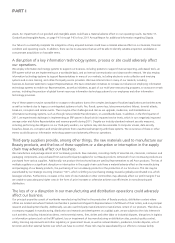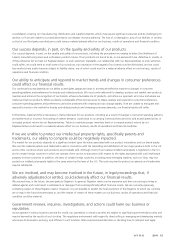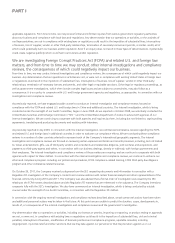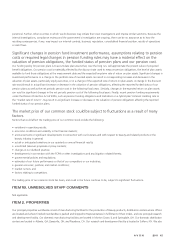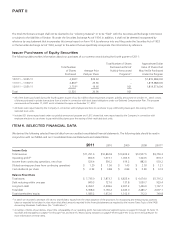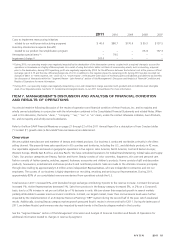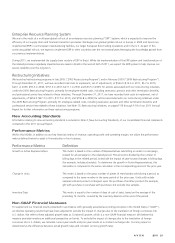Avon 2011 Annual Report Download - page 20
Download and view the complete annual report
Please find page 20 of the 2011 Avon annual report below. You can navigate through the pages in the report by either clicking on the pages listed below, or by using the keyword search tool below to find specific information within the annual report.PART I
assets. An impairment of our goodwill and intangible assets could have a material adverse effect on our operating results. See Note 17,
Goodwill and Intangible Assets, on page F-41 through F-43 of our 2011 Annual Report for additional information regarding Silpada.
Our failure to successfully complete the integration of any acquired business could have a material adverse effect on our business, financial
condition and operating results. In addition, there can be no assurance that we will be able to identify suitable acquisition candidates or
consummate acquisitions on favorable terms.
A disruption of a key information technology system, process or site could adversely affect
our operations.
We employ information technology systems to support our business, including systems to support financial reporting, web-based tools, an
ERP system which we are implementing on a worldwide basis, and an internal communication and data transfer network. We also employ
information technology systems to support Representatives in many of our markets, including electronic order collection and invoicing
systems and on-line training, and utilize third-party service providers. We have Internet sites in many of our markets, including
business-to-business websites to support Representatives. We have undertaken initiatives to increase our reliance on employing information
technology systems to enable our Representatives, as well as initiatives, as part of our multi-year restructuring programs, to outsource certain
services, including the provision of global human resources information technology systems to our employees and other information
technology processes.
Any of these systems may be susceptible to outages or disruptions due to the complex landscape of localized applications and architectures
as well as incidents due to legacy or unintegrated systems or both, fire, floods, power loss, telecommunications failures, terrorist attacks,
break-ins, corruption and similar events. There may be other challenges and risks as we upgrade, modernize, and standardize our
information technology systems, such as through Service Model Transformation, on a worldwide basis. In addition, in the third quarter of
2011, we experienced challenges in implementing an ERP system in Brazil which impacted service levels, which in turn negatively impacted
average order and Active Representative and revenue growth during 2011. Despite our industry-standard network security measures,
including performing due diligence on our third-party vendors, our systems may also be vulnerable to computer viruses, data security
breaches, break-ins, corruption and similar disruptions from unauthorized tampering with these systems. The occurrence of these or other
events could disrupt our information technology systems and adversely affect our operations.
Third-party suppliers provide, among other things, the raw materials used to manufacture our
Beauty products, and the loss of these suppliers or a disruption or interruption in the supply
chain may adversely affect our business.
We manufacture and package almost all of our Beauty products. Raw materials, consisting chiefly of essential oils, chemicals, containers and
packaging components, are purchased from various third-party suppliers for our Beauty products. Almost all of our non-Beauty products are
purchased from various suppliers. Additionally, we produce the brochures that are used by Representatives to sell Avon products. The loss of
multiple suppliers or a significant disruption or interruption in the supply chain could have a material adverse effect on the manufacturing
and packaging of our Beauty products, the purchasing of our non-Beauty products or the production of our brochures. This risk may be
exacerbated by our strategic sourcing initiative (“SSI”), which is shifting our purchasing strategy toward a globally-coordinated one, which
leverages volumes. Furthermore, increases in the costs of raw materials or other commodities may adversely affect our profit margins if we
are unable to pass along any higher costs in the form of price increases or otherwise achieve cost efficiencies in manufacturing and
distribution.
The loss of or a disruption in our manufacturing and distribution operations could adversely
affect our business.
Our principal properties consist of worldwide manufacturing facilities for the production of Beauty products, distribution centers where
offices are located and where finished merchandise is packed and shipped to Representatives in fulfillment of their orders, and one principal
research and development facility. Additionally, we also use third party manufacturers to manufacture certain of our products. Therefore, as
a company engaged in manufacturing, distribution and research and development on a global scale, we are subject to the risks inherent in
such activities, including industrial accidents, environmental events, fires, strikes and other labor or industrial disputes, disruptions in logistics
or information systems (such as the ERP system), loss or impairment of key manufacturing or distribution sites, product quality control,
safety, licensing requirements and other regulatory or government issues, as well as natural disasters, pandemics, border disputes, acts of
terrorism and other external factors over which we have no control. These risks may be exacerbated by our efforts to increase facility


